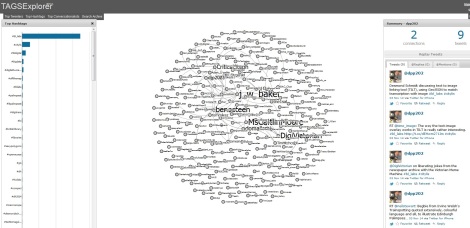Making the most of our reading week a group of us met up on Monday to attend the British Library Labs Symposium for 2014…
I won’t go into too much detail about the event itself (check out this post and this post for more information), but I think we all agreed that it was a fascinating day, very relevant for many of the things we have looked at so far on the course and providing much food for thought. There were various talks exploring the possibilities and challenges of using Big Data in the humanities, and more specifically promoting and encouraging the use, and remixing, of the BL’s already huge and ever growing digitised collections of text, images, and AV materials.
What I wanted to talk about in this post, linking back to our last DITA session (Archiving, Understanding and Visualising Twitter Data) was how attendees used Twitter at the event, and looking at this retrospectively with Martin Hawksey’s TAGS (Twitter Archiving Google Spreadsheet) programme.
I was aware (but somewhat sceptical) of live-tweeting before the symposium, but as a relatively recent Twitter user I had not yet had a go at it myself. Although I started off in my comfort zone during Tim Hitchcock’s keynote, scribbling notes in my trusty pad, I quickly realised this was no way for a #citylis student to behave. I decided to join my already tweeting coursemates in trying to highlight particularly interesting parts of the talks, and tagging them with both the event’s hashtag (#bl_labs), as well as the all-important #citylis. Our enthusiasm did not go unnoticed:
I was certainly not against the idea of live-tweeting for events such as this, and could see the obvious benefits of allowing a much bigger audience to participate in the debate and get involved from afar, but personally I worried that it would take away from my ability to concentrate on the speakers and really take in what they were saying. Although this was at times the case, where occasionally I would be a bit distracted tapping away on my phone and maybe miss a small part of a talk, I also very quickly saw how live-tweeting can actually help you to focus a bit more as you absorb the new information, and then attempt to summarise it as quickly as possible into the requisite 140 characters.
Also by participating in and following the Twitter discourse (from people both inside and outside the room) alongside the presentations and Q&As, I felt that I gained a more rounded understanding of the issues being discussed, by taking in a wider range of opinions and reactions than would have been otherwise possible. Overall then, from my (albeit limited) experience, I would argue that the positives of live-tweeting far outweigh the negatives, and I hope that with a bit more practice I can hone my skills to the level where it feels just as natural as old-school note-taking!
In terms of looking back after the event I have enjoyed having a play around with the aforementioned TAGS. We practiced with TAGS in our last DITA lab session, sparking a flurry of #citylis tweets linking to what we had created, which also didn’t go unnoticed:
TAGS is a great tool, mashing up Twitter and Google APIs (see previous post) to allow quick and easy archiving and analysis of tweets over a 7 day period, selected with certain criteria such as a hashtag. One of the key themes at the BL symposium was how huge amounts of data can be visualised, and this is something that TAGS does very well with its Explorer function. This displays a slightly hypnotic network of Twitter users based on the information entered into the original TAGS worksheet, such as #bl_labs in this case, and allows you to interact with this in various ways.
A quick analysis of the #bl_labs TAGS archive shows that the #citylis contingent did indeed make our presence known, with our hashtag placing second in the rankings and our handles featuring prominently in the centre of the visualised network. As well as being generally fun and interesting to use (and promoting a bit of healthy competition to climb up the ranks and make your own name bigger!), projects such as TAGS also have the potential to be used as serious academic tools for measuring the impact of research across various networks, and the success of events such as the BL Labs symposium.
This takes us into the realm of altmetrics, which (along with standard metrics) continue to cause much debate and scepticism in the academic community, something I hope to discuss further in my next post when I will have had even more time to experiment with TAGS and see what is possible…

Pingback: Collecting Echoes | Digital Information & Technology Adventures·
Pingback: Discovering Alternative Metrics | David Phillips on DITA·